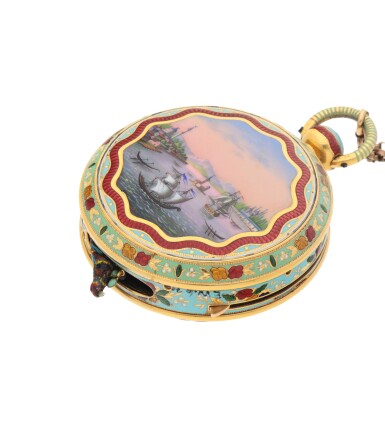Important Watches
Important Watches

FRÈRES ROCHAT | A MAGNIFICENT AND EXCEPTIONALLY RARE GOLD AND ENAMEL WATCH WITH SINGING BIRD AUTOMATON EMERGING FROM THE CASE SIDE MADE FOR THE TURKISH MARKET CIRCA 1820, NO. 202
This lot has been withdrawn
Lot Details
Description
FRÈRES ROCHAT
A MAGNIFICENT AND EXCEPTIONALLY RARE GOLD AND ENAMEL WATCH WITH SINGING BIRD AUTOMATON EMERGING FROM THE CASE SIDE MADE FOR THE TURKISH MARKET
CIRCA 1820, NO. 202
• Movement: gilded, cylinder escapement, plain balance with spiral spring, the singing bird released from the case side, bellows and singing controlled via a sliding stack of cams, further fixed cams for controlling the bird's movements, stamped FR within an oval cartouche for Frères Rochat and numbered 202
• Dial: white enamel, Roman numerals, aperture for winding, gold moon hands
• Case: gold, case back polychrome enamel painted with a harbour scene, surrounded by a translucent red enamel scalloped border, bezels decorated with flowers, foliage and berries in opaque white & turquoise enamel and translucent blue, green, red and yellow enamels over engraved decoration, all against an opaque turquoise ground, the band and pendant decorated en suite, bow with bands of opaque turquoise enamel, long slide to case side which simultaneously retracts hatch to base releasing the bird and uncovers sliding panel beside pendant for venting, the bird covered with multi-coloured feathers appearing on a golden branch with turquoise-set leaves, inside case back numbered 202 and 12704
diameter 52mm
The Sir David Salomons Collection
Vera Bryce Salomons
L. A. Mayer Memorial Institute, Jerusalem, inventory no. EW 6-70
George Daniels & Ohannes Markarian, Watches and Clocks in the Sir David Salomons Collection, 1980, p. 161, figs. 94 & 94a
Alfred Chapuis & Edouard Gélis, Le Monde des Automates, 1928, Tome II, p. 122 & p. 123, fig. 400
Eugène Jaquet & Alfred Chapuis, Technique and History of the Swiss Watch, 1970, p. 154 & plate 98
Ian White, The Majesty of the Chinese-Market Watch, 2019, p. 214, fig. 5.117
Watches with singing birds are exceptionally rare and the present watch, Frères Rochat no. 202, is one of the most famous examples known. This magnificent watch has been illustrated and described in a range of important horological literature, notably the seminal 1928 work on automata by Alfred Chapuis and Edouard Gélis: Le Monde des Automates, where it is described by the authors as "une superbe montre"and Eugène Jaquet and Alfred Chapuis’ highly respected work, Technique and History of the Swiss Watch. The rarity of the singing bird watch genre is largely due to the complexity of constructing a suitably small mechanism – for this reason singing bird automata are more commonly found within the larger dimensions of snuff boxes or within exotic bird cages. Of the small number of singing bird watches known, the rarest are those featuring the complex arrangement of a bird rising from within the case. Simpler versions of the complication exist, including birds on full view either singing within a cage that is mounted to a watch’s dial, or perched on a branch fitted to the dial. Those with rising birds include Frères Rochat no. 268 (Sotheby’s London, 14 July 2020, lot 42), an unsigned pearl and enamel set singing bird watch (Sotheby’s New York, 22 June 1988, lot 894) and an example signed Hillaire Bassereau – most likely the retailer (Fitzwilliam Museum Cambridge, illustrated in Chapuis/Droz, Automata, 1958, 1958, p.202, fig. 245). In the three aforementioned watches the bird rises from beneath a hinged lid. The present example is particularly unusual and captivating for the bird, which is perched on a branch, emerges from the case side and positions itself on the edge of the watch's case. Consequently, the bird may be viewed from all angles throughout its action, without the obstruction of a cover or lid. For another example of a singing bird watch emerging from a watch’s case band, see: C. Clutton & George Daniels, Watches, 1979, fig. 247 a-d; this latter watch has a plain guilloché enamel back centred by an enamel painted flower and the bird is activated via the pendant rather than a slide.
The mechanical singing bird is one of the most admired of all automata, those produced by the firm of Frères Rochat are renowned for their exceptional quality, realistic bodily movements and the mellifluous tone of their song. The firm worked with the finest case makers who housed their automata in exquisite gold cases, richly adorned with decorative enamel panels and polychrome painted scenes which might be further embellished with pearls and other precious materials. The horologer David Rochat (1746-1812) of Le Brassus in the Vallée du Joux worked at the end of the 18th century with his three sons Jacques François Elisée (1771-1836), David Frédéric Henri (1774-1848) and Henri Samuel (1777-1854). The Rochats who supplied Jaquet-Droz with singing bird ébauches also spent some time at Frédéric Leschot’s workshop in Geneva. David Rochat is mentioned in the Jaquet-Droz account books as early as 1802. Jaquet-Droz’s chief singing bird specialist was Jacob Frisard. Frisard is generally believed to have been responsible for inventing the whistle and sliding piston that enabled the miniaturization of the singing bird automaton. David Rochat and his sons were perfectly positioned to learn the design and construction of Jaquet Droz and Leschot’s singing bird movements, and the brothers would go on to set up an independent business in Geneva (which later included members of their extended family), to produce singing bird movements of outstanding quality.
